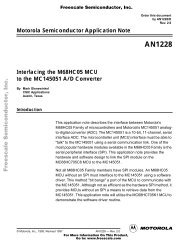The MC145170 in Basic HF and VHF Oscillators - LANSDALE ...
The MC145170 in Basic HF and VHF Oscillators - LANSDALE ...
The MC145170 in Basic HF and VHF Oscillators - LANSDALE ...
You also want an ePaper? Increase the reach of your titles
YUMPU automatically turns print PDFs into web optimized ePapers that Google loves.
20 pF<br />
1 MHz<br />
Y1<br />
1 MΩ<br />
1 16<br />
<strong>MC145170</strong><br />
+ 5 V<br />
4 x 5.6 kΩ<br />
2 x 1500 pF<br />
R1/2<br />
R1/2<br />
CC<br />
R1/2 R1/2<br />
CC<br />
24 kΩ 4700 pF<br />
+ 12 V<br />
–<br />
LF351<br />
+<br />
24 kΩ<br />
20 pF 100 pF<br />
8 9<br />
1 kΩ<br />
4700 pF<br />
OUTPUT<br />
DATA OUT<br />
CLK<br />
EN<br />
DATA IN<br />
TEST POINT<br />
(LOCK DETECT)<br />
+ 5 V<br />
+ 5 V<br />
1<br />
14<br />
20 nH<br />
2 x MV2115<br />
R14<br />
10 kΩ<br />
MC1648<br />
1000 pF<br />
7 8<br />
0.1 µF 390 pF<br />
C5<br />
Figure 5. V<strong>HF</strong> Synthesizer<br />
midpo<strong>in</strong>ts to ground to further filter the reference sideb<strong>and</strong>s.<br />
<strong>The</strong> value of CC is chosen so that the corner frequency of this<br />
added network does not significantly affect the orig<strong>in</strong>al loop<br />
b<strong>and</strong>width ωB.<br />
<strong>The</strong> rule of thumb for an <strong>in</strong>itial value is CC = 4 / ( R1 ωRC),<br />
where ωRC is the filter cutoff frequency. A good value is to<br />
choose ωRC to be 10 x ωB, so as to not significantly impact the<br />
orig<strong>in</strong>al filter.<br />
ωB = ωn 1 + 2ζ2 + 2 + 4ζ2 + 4ζ4 (8)<br />
= 12,566 1+(2)(0.707)2+ 2+(4)(0.707)2+ (4)(0.707)4<br />
= 25,860 rad/s<br />
ωRC = 10 ωB = (10)(25,860) = 258,600 rad/s<br />
4<br />
4<br />
CC = =<br />
R1ωRC (11.23 kΩ)(258,600 rad/s)<br />
= 1377 pF ≈ 1500 pF<br />
(9)<br />
(10)<br />
<strong>The</strong>re is also a filter formed at the <strong>in</strong>put to the VCO. Aga<strong>in</strong>,<br />
this should be selected to ensure that it does not significantly<br />
affect the loop b<strong>and</strong>width. For this example, the filter is dom<strong>in</strong>ated<br />
by R14 with C5. <strong>The</strong> capacitance of the varactors (<strong>in</strong><br />
series with the rest of the circuit) is much smaller than C5 <strong>and</strong><br />
can therefore be neglected for this calculation.<br />
As above, let ωRC = 258,600 rad/s be the cutoff of this filter.<br />
R14 is chosen to be 10 kΩ. <strong>The</strong>refore,<br />
1<br />
1<br />
C5 = =<br />
ωRCR14 (258,600)(10 kΩ)<br />
= 387 pF ≈ 390 pF<br />
THE VARACTOR<br />
(11)<br />
<strong>The</strong> MV2115 was selected for its tun<strong>in</strong>g ratio of 2.6 to 1.<br />
<strong>The</strong> capacitance can be changed from 49.1 pF to 127.7 pF<br />
over a reverse bias sw<strong>in</strong>g of 2 to 30 volts. Contact your Motorola<br />
representative for <strong>in</strong>formation regard<strong>in</strong>g the MV2115 varactor<br />
diode.<br />
For example, three parameters are considered.<br />
CT = Nom<strong>in</strong>al capacitance<br />
CR = Capacitance ratio<br />
fR = Frequency ratio<br />
CR= C vm<strong>in</strong><br />
=<br />
Cvmax<br />
where ρ = the capacitance exponent<br />
Vmax<br />
Vm<strong>in</strong><br />
ρ<br />
(12)<br />
AN1207<br />
4<br />
MOTOROLA






